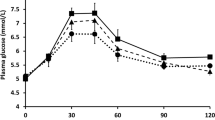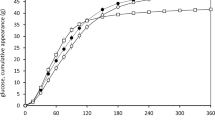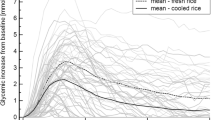Abstract
Objective: The aim of this study was to determine the impact of variety, cooking method and maturity on the GI of potatoes, it was hypothesised that new potatoes may have a relatively lower GI.
Design and subjects: Ten healthy volunteers were recruited as subjects through advertising on the campus of the University of Sydney. Equal (50 g) carbohydrate portions of eight potato meals (three varieties, four cooking methods, two states of maturity) and two reference white bread meals were fed in random order to each of the subjects over a period of 10 weeks. Capillary blood samples were taken in the fasting state and then at 15, 30, 45, 60, 90 and 120 min from the start of each meal. Samples were analysed for plasma glucose concentrations and incremental areas under plasma glucose curves were calculated. The GI of the potato was calculated as the AUC of the potato expressed as a percentage of the individual’s average AUC of the white bread. This was then multiplied by 0.7 to index the GI to glucose as the reference food.
Results: GI values (mean±s.e.m.) ranged from 65±9 (canned new potatoes) to 101±15 (boiled Desiree potatoes), glucose=100. No significant difference was found among the three varieties of potato tested (P=0.38) or among the four different cooking methods (P=0.55). The GI values of the canned new potato and boiled Desiree potato were significantly different (P=0.047). The average size of the tuber was found to correlate with the GI (r=0.83, P<0.05).
Conclusions: Potatoes, regardless of variety, cooking method and maturity, have exceptionally high GI values. New potatoes have relatively lower GI values which is attributed to differences in starch structure.
Sponsors: University of Sydney.
This is a preview of subscription content, access via your institution
Access options
Subscribe to this journal
Receive 12 print issues and online access
$259.00 per year
only $21.58 per issue
Buy this article
- Purchase on Springer Link
- Instant access to full article PDF
Prices may be subject to local taxes which are calculated during checkout
Similar content being viewed by others
Author information
Authors and Affiliations
Rights and permissions
About this article
Cite this article
Soh, N., Brand-Miller, J. The glycaemic index of potatoes: the effect of variety, cooking method and maturity. Eur J Clin Nutr 53, 249–254 (1999). https://doi.org/10.1038/sj.ejcn.1600713
Received:
Revised:
Accepted:
Published:
Issue Date:
DOI: https://doi.org/10.1038/sj.ejcn.1600713
Keywords
This article is cited by
-
Effect of some traditional processing operations on the chemical, functional, antioxidant, glycaemic index and glycaemic load of groundnut (Arachis hypogea L.) seed flour
Journal of Food Measurement and Characterization (2022)
-
Potatoes and risk of chronic disease: a systematic review and dose–response meta-analysis
European Journal of Nutrition (2019)
-
The In Vitro Digestibility of Carbohydrates in Boiled and Processed Potatoes
Potato Research (2015)
-
Starch Characteristics of Modern and Heirloom Potato Cultivars
American Journal of Potato Research (2013)
-
Starch Digestibility and Dry Matter Roles in the Glycemic Impact of Potatoes
American Journal of Potato Research (2012)



